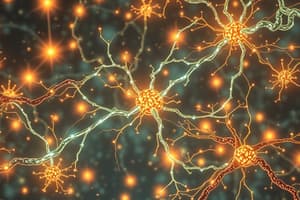Podcast
Questions and Answers
What is the primary function of synaptic vesicles located in the synaptic knobs?
What is the primary function of synaptic vesicles located in the synaptic knobs?
- To synthesize neurotransmitters from raw materials.
- To break down neurotransmitters after they have acted on the post-synaptic membrane.
- To provide structural support to the synapse.
- To store and protect neurotransmitters before release. (correct)
Which of the following best describes the direction of an efferent nerve impulse?
Which of the following best describes the direction of an efferent nerve impulse?
- From the sensory organs to the spinal cord.
- From the brain and CNS to the muscles or glands. (correct)
- From one sensory neuron to another sensory neuron.
- Within the brain, connecting different regions.
How do local anesthetics work to block pain transmission?
How do local anesthetics work to block pain transmission?
- By decreasing the blood flow to the affected area.
- By stimulating the release of neurotransmitters in pain centers.
- By binding to and inhibiting ion channels in the nerve cell membrane. (correct)
- By increasing the rate of nerve impulse transmission.
What is the immediate fate of neurotransmitters after they act on the post-synaptic membrane?
What is the immediate fate of neurotransmitters after they act on the post-synaptic membrane?
Which of the following processes is directly involved in the release of neurotransmitters into the synaptic cleft?
Which of the following processes is directly involved in the release of neurotransmitters into the synaptic cleft?
In the context of the nervous system, what is a synapse?
In the context of the nervous system, what is a synapse?
Trigeminal neuralgia is a condition characterized by excessive nerve impulses. Which nerve is primarily affected in this condition?
Trigeminal neuralgia is a condition characterized by excessive nerve impulses. Which nerve is primarily affected in this condition?
The herpes simplex virus, which can cause cold sores, remains dormant in which structure?
The herpes simplex virus, which can cause cold sores, remains dormant in which structure?
Flashcards
Afferent Nerve Impulse
Afferent Nerve Impulse
A nerve impulse running TO the brain and CNS, carrying sensory information.
Efferent Nerve Impulse
Efferent Nerve Impulse
A nerve impulse running FROM the brain and CNS, carrying motor commands.
Synapse
Synapse
The point where a nerve impulse jumps from one nerve to another.
Synaptic Vesicles
Synaptic Vesicles
Signup and view all the flashcards
Neurotransmitter
Neurotransmitter
Signup and view all the flashcards
Exocytosis (in Synaptic Transmission)
Exocytosis (in Synaptic Transmission)
Signup and view all the flashcards
Neuralgia
Neuralgia
Signup and view all the flashcards
Trigeminal Nerve & Herpes Simplex
Trigeminal Nerve & Herpes Simplex
Signup and view all the flashcards
Study Notes
- An impulse can start when sensory nerve endings are simulated or when an impulse comes from another nerve.
- Afferent (sensory) nerve impulses travel to the brain and central nervous system (CNS).
- Efferent (motor) nerve impulses travel from the brain and CNS.
- Ion channels in the axon are voltage-gated.
- Depolarisation at one axon segment causes the ion channels in the next segment to open.
- Action potential travels along the axon as a wave of depolarisation.
Overview of Neural Impulse
- In a resting neuron, Na+ and K+ gates are closed, maintaining a polarized state.
- During action potential, an excitatory stimulus opens sodium channels, allowing Na+ ions to flow into the neuron.
- Subsequently, potassium channels open, allowing K+ ions to flow outward.
- Charge restoration involves the sodium-potassium pump, restoring the original ion distribution by pumping Na+ out and K+ in.
- Nerve impulses travel down the neuron.
- Nerves are not physically joined or connected.
- Synapse defines the point where a nerve impulse jumps from one nerve to another.
- The brain contains approximately 1000 trillion synapses.
- Synaptic knobs contain spherical, membrane-bound synaptic vesicles that store neurotransmitters, released into the synaptic cleft.
The Journey of a Neurotransmitter
- Synthesized by nerve cell bodies
- Actively transported along the axons
- Stored in the synaptic vesicles
- Released by exocytosis in response to the action potential
- Diffuse across the synaptic cleft
- Act on specific receptor sites on the postsynaptic membrane
- Action is short lived
- After action, either inactivated by enzymes or taken back into the synaptic knob
Local Anaesthetics and Neuralgia
- Local anesthetics work by blocking nerve transmission to pain centers in the central nervous system.
- They bind to and inhibit the function of an ion channel in the cell membrane of nerve cells, specifically the sodium channel.
- This action obstructs the movement of nerve impulses near the injection site, without affecting awareness or sense perception in other areas.
- Excessive nerve impulses can result in neuralgia, most commonly trigeminal neuralgia.
- The herpes simplex virus lies dormant in the trigeminal ganglion. When reactivated, it travels down the trigeminal nerve, emerging on the lip and causing a cold sore.
Studying That Suits You
Use AI to generate personalized quizzes and flashcards to suit your learning preferences.
Related Documents
Description
Explore neural impulses: Sensory impulses travel to the brain and motor impulses travel from the brain. Voltage-gated ion channels in the axon facilitate action potential through depolarization. The sodium-potassium pump restores charge by moving Na+ out and K+ in.




